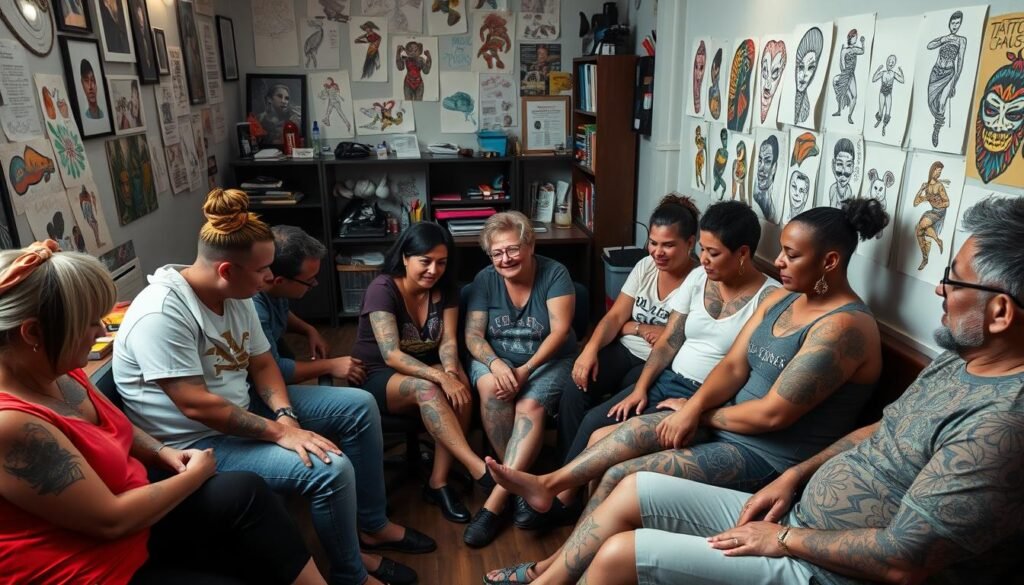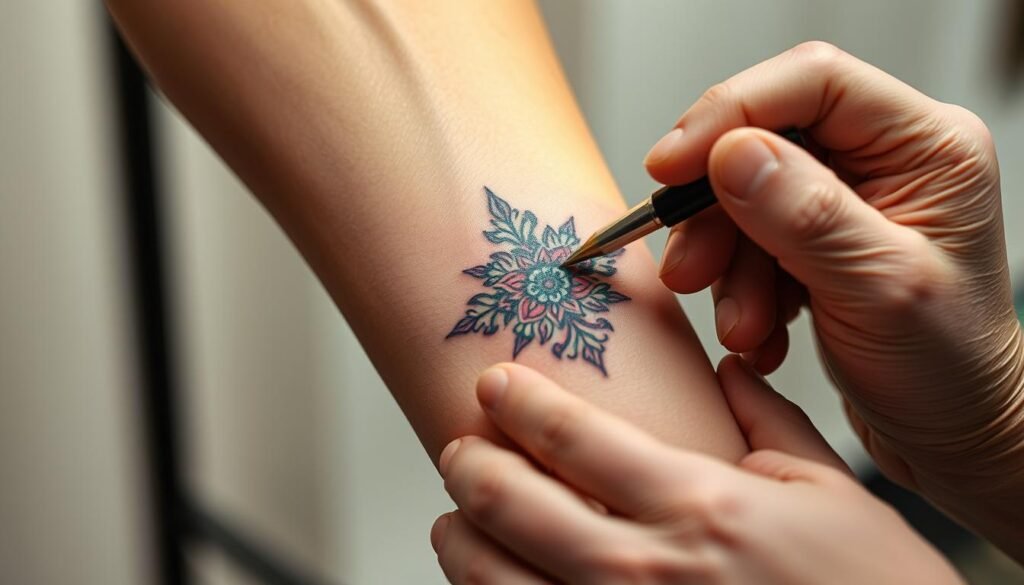Did you know tattoos can reduce stress hormone cortisol by up to 30%? This finding shows tattoos’ role in enhancing mental health. People looking for anxiety relief increasingly turn to body art. Tattoos allow for self-expression and have a therapeutic effect. They turn personal challenges into visual stories. Semicolon tattoos, for instance, symbolize a pause not an end, while butterflies stand for transformation. Check out the mental health benefits of tattoos for inspiration.
Key Takeaways
- Tattoos can significantly lower cortisol levels, reducing stress and anxiety.
- Body art serves as a reminder of personal journeys and fortitude.
- Symbols like butterflies and semicolons convey messages of hope and resilience.
- Certain designs, such as mandalas, promote relaxation and mindfulness.
- Tattoos can contribute to increased self-esteem and personal empowerment.
The Therapeutic Benefits of Tattoos
Tattoos are more than just art; they’re a form of therapy and healing. Places like San Diego are seeing a rise in tattoo therapy. Body art is used to face personal challenges and express inner feelings. Tattoos become important symbols in the journey toward mental well-being.
Exploring the Healing Power of Body Art
Body art is essential for emotional health. People pick symbols that have deep meaning to them. They narrate their victories over hard times through their skin. Tattoos symbolizing resilience can comfort those battling anxiety or depression. The lasting nature of tattoos serves as a constant reminder of inner strength.
Depression tattoos, such as the semicolon, share stories of mental health struggles. They spark discussions on awareness and support.
The Role of Ink Therapy in Mental Health
Ink therapy is gaining recognition for its mental health perks. Getting a tattoo can be a way to work through emotions and transform pain into art. Many find empowerment and control in this process.
Tattoo therapy helps people take charge of their stories. It also builds a supportive relationship with tattoo artists, who play a key role in their emotional recovery. As tattoos become more accepted, their role in mental health, self-care, and connection grows.
Tattoos as a Form of Self-Expression
Tattoos are powerful tools for showing who we are inside. They let people show their thoughts and feelings with unique designs. With tattoos, individuals can experience freedom and an emotional outlet. They offer a way to share personal stories visually, especially when words fall short.
Communicating Inner Thoughts and Feelings
Tattoos mirror life’s ups and downs in a very personal way. They stand as symbols of strength, reminding us of our resilience. Our bodies become canvases that tell our stories, ones not usually shared. Tattoos and mental health are linked, research shows. Getting a tattoo can be soothing and boost confidence.
People feel better about their looks and value their bodies more, particularly three weeks after getting inked. This finding is based on studies.
Creating Personal Narratives through Body Art
Tattoos tell the story of our lives, marking important moments and growth. Designing a tattoo can be healing, helping reduce stress. It’s a chance to reflect on personal beliefs and memories. This creative process is also a step towards accepting oneself and valuing our own stories.
The tattoo community is welcoming, sharing stories that lessen the sting of loneliness linked to mental health issues. For more insights, click here.
| Aspect | Description |
|---|---|
| Self-Expression | Tattoos enable individuals to communicate their personal thoughts and feelings. |
| Personal Narratives | Body art serves as a record of an individual’s journey, creating a visual representation of life experiences. |
| Mindfulness | The process of tattooing promotes being present and engaged in the moment. |
| Community | Shared stories within the tattoo culture foster a sense of belonging and connection. |
| Therapeutic Benefits | Tattoos contribute to emotional healing and improve body image. |
The Ritualistic Process of Getting Tattooed
Tattoos are more than just body art; they symbolize personal stories of pain, healing, and expression. The process of getting a tattoo is profound for many. It helps people regain control of their bodies after trauma or loss. Through this process, individuals can share their feelings and connect deeply with their experiences.
Reclaiming Control After Trauma or Loss
Getting a tattoo is a powerful healing ritual for many. Tattoo rituals for anxiety let people take control of their bodies during tough times. Tattoos give a sense of power when one has felt helpless from past hurts. By choosing meaningful designs, individuals can celebrate resilience and honor loved ones they’ve lost. This act helps recover a part of themselves lost to pain.
Turning Pain into Art
The act of tattooing can be a way to release emotions. The feel of the needle turns emotional pain into art. For many, this discomfort is a distraction from inner sadness. It helps transform it into something beautiful. This process can also make people more accepting of their scars. They start seeing them as stories of strength, not flaws.
| Benefits of Tattooing | Description |
|---|---|
| Empowerment | Allows individuals to take control of their bodies and narratives. |
| Catharsis | Transforms pain into a meaningful artistic representation. |
| Memorialization | Serves as a tribute to loved ones or significant experiences. |
| Community | Encourages connection and understanding among those with similar experiences. |
| Mindfulness | Promotes a meditative state during the tattooing process. |
Getting tattooed blends psychological depth with art. As people work through their feelings, tattoos stand as symbols of toughness, healing, and growth.
How Tattoos Can Help with Anxiety Relief
Tattoos are powerful symbols of personal strength for many. They remind people of their resilience and growth, especially when dealing with anxiety. The designs often stand for overcoming mental challenges. They act as positive affirmations for well-being.
More and more people are choosing tattoos related to mental health. This shows a change in how we talk about mental health openly. Between 2020 and 2021, there was a big jump in interest for these kinds of tattoos. It highlights the importance of tattoos in emotional health today.
Visual Reminders of Strength and Resilience
People choose tattoos that reflect their anxiety battles. Common symbols include semicolons and butterflies. The semicolon is linked to Project Semicolon. It’s a strong symbol of the mental health fight. Butterflies represent hope and change. These tattoos remind wearers of their strength every day.
Studies show that getting a tattoo can lower stress. This was found in research from the Journal of Alternative and Complementary Medicine. It shows tattoos can really help with stress. The process itself has benefits, helping people feel calmer and more at peace.
Transforming Emotional Pain into Art
Getting a tattoo turns pain into strength. Spiritual symbols like mandalas and lotus flowers are meaningful for those with anxiety. They represent safety and new starts. People feel better about themselves with these tattoos. They worry less about how they look.
This positive impact on body image is important. The American Journal of Human Biology found that tattoos might boost immune responses. This could help both mental and physical health. For many, tattoos are reminders of their healing journey.

| Symbol | Meaning | Common Use |
|---|---|---|
| Semicolon | Struggle and Continuation | Representing mental health recovery |
| Butterfly | Transformation and Hope | Empowerment narrative |
| Mandalas | Protection and Harmony | Spiritual healing |
| Lotus Flower | New Beginnings | Self-care practices |
| Chakra Symbols | Balance and Inner Peace | Mental wellness and mindfulness |
The Connection Between Tattoos and Mindfulness
Getting tattoos connects art with mindfulness, creating deep focus. When being tattooed, people immerse themselves in the moment. This has emotional, mental, and grounding benefits.
Practicing Presence through the Tattooing Experience
The tattoo process is like meditation for many. It helps them live in the now and eases their worries. Tattoos boost self-esteem and help people express who they are.
Endurance and Patience in the Tattoo Process
Getting a tattoo requires endurance and patience. It’s about facing the needle’s pain and the emotions behind the tattoo. Tattoos symbolize healing and resilience for many.
Community and Connection within the Tattoo Culture
Tattoos often draw people together, helping fight loneliness. Many find that their tattoos do more than express themselves; they act as a bridge. These inked designs lead to communities where stories and support flow freely, giving everyone a sense of belonging.
Sharing Stories to Overcome Loneliness
Sharing the stories behind tattoos can be comforting. When people open up about their tattoos, they connect with others who’ve struggled too, with things like addiction or loss. This act of sharing becomes a powerful way for community healing through tattoos. Talking about our tattoos invites empathy and understanding, breaking down walls of loneliness.
Forming Supportive Networks through Body Art
Tattoos symbolize personal stories and help build support networks. These networks spread from local tattoo shops to worldwide social media groups. This collective sharing promotes mental health and encourages connections, enhancing the healing power of tattoos.

Art Therapy and the Creative Process
Art therapy is key in tackling stress and anxiety. It lets people show their feelings through art. Tattoos, as a special kind of art, help in sharing emotions and personal stories. Making tattoos for healing encourages mindfulness and makes the process therapeutic.
Reducing Stress through Artistic Engagement
Art therapy offers peace through hands-on activities like tattooing. The tattoo machine’s vibrations can be as calming as brush strokes on canvas. This not only relaxes but also connects people, making them feel seen. For those hard to express themselves, it’s a way to communicate without words. Learn more in this conversation about the relief of pain through ink.
The Role of Colors and Designs in Healing
Choosing colors and designs in tattoos impacts healing. Certain colors stir specific feelings that support recovery. Warm colors like red and orange boost energy while cool colors bring peace. This shows how art in tattoos plays a part in mental health and well-being.
| Color | Emotional Impact | Therapeutic Use |
|---|---|---|
| Red | Energy, Passion | Motivation Boost |
| Blue | Calm, Stability | Anxiety Reduction |
| Green | Growth, Renewal | Healing Journey |
| Purple | Creativity, Spirituality | Self-Exploration |
Transforming Scars into Beautiful Artwork
Turning scars into tattoos is more than just changing skin appearance. It marks a deep emotional healing journey. For many, scars are reminders of tough times. By choosing tattoos, they weave new stories around their scars. They change how they see these skin marks.
Enhancing Body Image with Meaningful Tattoos
Getting tattoos for healing changes how people see their bodies. Scars no longer bring shame but pride instead. For instance, raised scars can seem like a burden. But, with beautiful tattoos, they stand as symbols of power. This change boosts confidence and empowerment feelings.
Emotional Healing through Skin Transformations
The mental benefits of transforming scars into tattoos are big. Covering scars with tattoos brings relief. It turns years of guilt into symbols of toughness. Support from others plays a key role in healing. Groups like Project New Moon show how shared stories help. The demand for cover-up tattoos shows many wish to heal and reclaim their self-image. Turning scars into art is a journey of care and emotional health.

| Type of Scar | Description | Tattoo Benefits |
|---|---|---|
| Hypertrophic | Thick and raised scars, often red, occurring due to excessive collagen production. | Can be transformed into beautiful designs, symbolizing strength. |
| Keloids | Scar tissue that extends beyond the original injury, challenging to treat. | Artistic tattoos can help mask the appearance. |
| Atrophic | Sunken scars that may arise from acne or chickenpox. | Artistry can redefine the area, enhancing self-image. |
| Contracture | Generated from burns, which can tighten skin and hinder movement. | Transformative tattoos can inspire healing and restoration. |
Personal Growth and Self-Acceptance through Tattoos
Tattoos often show important times in a person’s life. They are more than just designs. They carry deep meaning. They remind us to accept ourselves through ink. Many people get tattoos to remember big moments and successes. This shows how tattoos help with personal growth. They highlight our strength and change.
Celebrating Milestones and Achievements with Ink
For many, tattoos represent big life moments. This includes beating challenges or celebrating wins. Think of symbols like the semicolon, butterfly, and phoenix. Each means something special. The semicolon stands for resilience. The butterfly shows change. These tattoos honor personal wins. They also help us accept ourselves through ink.
Tattoos as Symbols of One’s Journey
Tattoos can tell a story about one’s life and struggles. In places like San Diego, more people use tattoos to show their healing and acceptance. Symbols like the lotus flower and the brain with flowers are popular. The lotus means rebirth. The brain with flowers talks about mental health. Getting a tattoo makes people feel strong and connected. It builds understanding among those facing similar issues.
| Symbol | Meaning | Example Use |
|---|---|---|
| Semicolon | Resilience | Representation of choosing to continue life |
| Butterfly | Transformation | Emblem of personal growth and hope |
| Lotus Flower | Purity and Rebirth | Signifying overcoming adversity |
| Phoenix | Renewal | Symbol of overcoming addiction or challenges |
| Brain with Flowers | Mental Health Awareness | Highlighting self-care and mindfulness |
This tattoo trend for growth connects people. It lets them share their stories of strength and resilience. Each tattoo is filled with experiences and meanings. It shows how important tattoos are in the journey to accepting and empowering ourselves.
Conclusion
Tattoos are becoming a popular way to deal with anxiety. They offer deep therapeutic benefits as more people choose them for emotional healing. This trend highlights how tattoos can make people feel better during hard times. Research shows many use tattoos to help with mental health issues like anxiety.
The tattoo industry also has a big economic impact, making billions each year. Its growth shows how more people see tattoos as a form of self-care. Younger folks especially find tattoos helpful for their mental health. Tattoos let people tell their own stories and feel better about themselves.
In short, tattoos can’t replace mental health treatment, but they help. They are a way for people to feel better alongside other treatments. As tattoos become more accepted, more people see their value in mental health. Anyone interested should consider how tattoos might help them feel and live better.